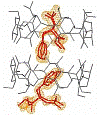Department of Chemistry
Date of this Version
July 1980
Abstract
Crystal structures of the charge transfer complex between anthracene and tetracyanobenzene, A:TCNB, C14H10: C10H2N4, at three temperatures (297, 234 and 226 K) above the order–disorder phase transition at 206 K and at four temperatures (202, 170, 138, and 119 K) below it have been determined from x-ray diffraction data. The space group of the room temperature phase was assigned as Cm with a = 9.528(2), b =12.779(3), c = 7.441(2) Å and β=92.39(2) degrees at 297 K and for the low temperature phase is P21/a with a =9.457(1), b =12.689(2), c =7.325(1) Å and β=92.98(1)° at 119 K; Z = 2 in both phases. The electron densities, plotted for both the donor and acceptor molecules at each temperature, indicate that there is dynamic librational disorder in the A molecules that gives rise to a single average orientation in the room temperature phase. Below the phase transition, two temperature dependent, symmetry related, orientations are observed; the libration diminishes slowly as a function of temperature in this phase. There are also modest reorientations, relative to the room temperature phase, in the TCNB molecules as the crystal is cooled. Crystal packing indicates that a network of intermolecular dipole–dipole interactions between the heteroatomic acceptor molecules accounts for their lack of libration comparable to that of the donors.


Comments
Published in The Journal of Chemical Physics 73:1 (July 1, 1980), pp. 538-547. Copyright 1980 by The American Institute of Physics. Used by permission. doi:10.1063/1.439851